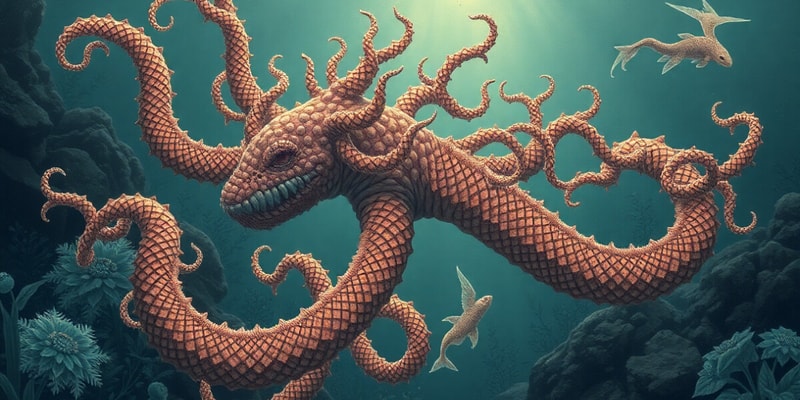Podcast Beta
Questions and Answers
What is the primary function of the tentacles and nematocysts in Hydra?
What occurs during the budding process in Hydra?
What is the role of the gonads in Hydra?
What type of body structure do diploblastic animals exhibit?
Signup and view all the answers
What is the function of the pedal disc in Hydra?
Signup and view all the answers
What type of water do hydras prefer for habitat?
Signup and view all the answers
Which part of the hydra is responsible for consuming food?
Signup and view all the answers
What is the primary mode of reproduction in hydra?
Signup and view all the answers
How do hydras primarily move in the water?
Signup and view all the answers
What is the typical size range of a hydra?
Signup and view all the answers
Study Notes
Hydra: Habitat and General Characteristics
- Solitary, free-living animal inhabiting freshwater lakes and ponds.
- Prefers still, clean, cool water; less common in dirty, warm, flowing water.
- Carnivorous, feeding using tentacles.
- Moves via tentacle use and body contraction/expansion.
- Respiration and excretion occur through the body wall by diffusion.
- Reproduces asexually (budding, fission) and sexually.
- Exhibits remarkable regenerative abilities.
Hydra: Systematic Position
- Kingdom: Animalia
- Phylum: Cnidaria (possesses cnidocytes and coelenteron)
- Class: Hydrozoa (undivided coelenteron)
- Order: Hydroida (polyp phase dominant)
- Family: Hydridae (solitary)
- Genus: Hydra (regenerative)
- Species: Hydra vulgaris (example species)
Hydra: External Features
- Soft, elongated, tubular body.
- Open (oral) and closed (aboral) ends; mouth located at oral end.
- Radially symmetrical; 10–30 mm long, ~1 mm wide.
- Color varies; Hydra vulgaris is colorless or light yellowish-brown, changing with food intake.
Hydra: External Morphology
- Hypostome: Conical, contractile structure at the free end; contains the mouth.
- Trunk: Contractile portion between the hypostome and basal disc.
- Pedal Disc: Basal disc used for attachment; secretes adhesive juice and produces bubbles for flotation.
- Tentacles: 6–10, longer than the body, hollow, contractile; used for feeding, locomotion, and defense. Contain nematocysts.
Hydra: Reproduction and Other Structures
- Budding: Asexual reproduction; occurs during summer with abundant food.
- Gonads: Temporary reproductive organs (testes and ovaries); form during breeding season (late autumn/winter).
- Tentacles and nematocysts function together in feeding, locomotion, and protection.
Hydra: Diploblastic Nature and Internal Structure
- Diploblastic animal (ectoderm and endoderm in embryo, epidermis and gastrodermis in adult); mesoglea present between layers.
- Simple body structure; lacks complex tissues, organ systems.
- Body wall comprises epidermis, gastrodermis, and mesoglea.
Hydra: Historical Context and Diversity
- Discovered and studied by Abraham Tremblay (1744), named by Carolus Linnaeus (1758).
- Approximately 40 species worldwide.
- Three species reported in Bangladesh: Hydra oligacuis, Hydra viridissima, and Hydra vulgaris. Hydra vulgaris is the most common in Bangladesh.
Studying That Suits You
Use AI to generate personalized quizzes and flashcards to suit your learning preferences.
Description
Explore the fascinating world of Hydra, a unique free-living organism found in freshwater environments. This quiz covers its habitat, general characteristics, systematic position, and external features, giving you insights into its remarkable biology and regenerative abilities. Test your knowledge on this intriguing member of the animal kingdom.




